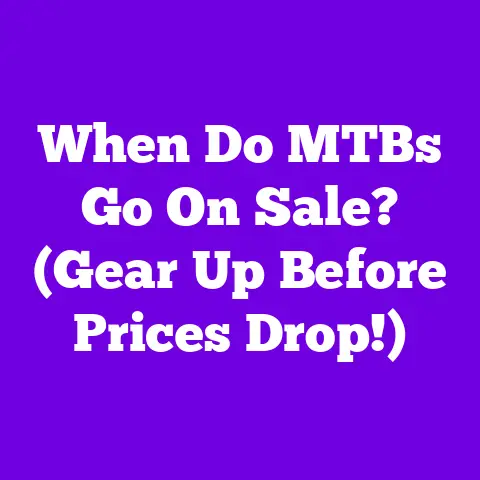Motivate sales Team When sales Are Down (Don’t Miss These Leads!)
Why did the sales person bring a ladder to the sales meeting?
Because they heard the quotas were through the roof!
Okay, bad jokes aside, let’s face it: sales slumps happen.
And in 2025, with the ever-shifting economic landscape and increasingly savvy customers, keeping your sales team motivated during a downturn can feel like an uphill battle.
But it’s not impossible.
In fact, it’s crucial.
A motivated sales team, even in tough times, is your best weapon against missed opportunities and dwindling revenue.
This article will give you the strategies you need to reignite that fire and turn the tide.
Section 1: Understanding the Sales Downturn
Let’s be honest, pinpointing the exact reason for a sales decline is rarely simple.
It’s often a cocktail of factors, both internal and external.
In 2025, several key trends are playing a significant role:
Economic Uncertainty: The global economy is still recovering from the shocks of recent years.
Inflation, interest rate hikes, and geopolitical instability are all creating uncertainty, leading to cautious spending habits among consumers and businesses alike.
According to a recent report by the International Monetary Fund (IMF), global growth is projected to be 3.2% in 2024 and 2.9% in 2025, a modest pace that reflects lingering economic headwinds.
International Monetary Fund – World Economic OutlookEvolving Consumer Behavior: Customers are more informed and demanding than ever before.
They research extensively online, compare prices across multiple platforms, and expect personalized experiences.
Traditional sales tactics are losing their effectiveness, and sales teams need to adapt to a more consultative and customer-centric approach.
A 2024 study by Deloitte found that 71% of consumers expect companies to deliver personalized interactions, and 76% get frustrated when this doesn’t happen.
Deloitte – The future of customer engagementIncreased Competition: The digital landscape has lowered the barriers to entry for new businesses, leading to increased competition in almost every industry.
Sales teams need to work harder to differentiate their products or services and stand out from the crowd.Disruptive Technologies: AI, automation, and other emerging technologies are transforming the sales process.
While these technologies can offer significant benefits, they also require sales teams to acquire new skills and adapt to new ways of working.
A report by McKinsey & Company estimates that AI could automate up to 30% of sales activities by 2030.
McKinsey & Company – Notes from the AI frontier: Modeling the impact of AI on the world economy
These external factors are often compounded by internal challenges, such as:
- Lack of Training: Sales teams may not have the necessary skills or knowledge to sell effectively in the current market.
- Inefficient Processes: Outdated sales processes can hinder productivity and lead to missed opportunities.
- Poor Lead Generation: A shortage of qualified leads can make it difficult for sales teams to meet their targets.
- Low Morale: When sales are down, morale can plummet, creating a negative cycle that further impacts performance.
Section 2: The Importance of Motivation
Motivation is the fuel that drives sales performance, especially when the road gets tough.
Think of it as the engine that keeps your team moving forward, even when faced with obstacles and setbacks.
Numerous psychological studies have demonstrated the link between motivation and performance.
- Increased Productivity: Motivated employees are more productive and efficient.
They are more likely to go the extra mile, work harder, and stay focused on their goals. - Improved Creativity and Innovation: Motivation fosters a sense of ownership and encourages employees to think creatively and come up with innovative solutions.
- Enhanced Customer Relationships: Motivated sales teams are more likely to build strong relationships with customers, leading to increased customer satisfaction and loyalty.
- Reduced Turnover: When employees feel valued and motivated, they are more likely to stay with the company, reducing turnover costs and preserving institutional knowledge.
A classic example of a company that turned around its sales performance through motivational strategies is IBM under the leadership of Lou Gerstner in the 1990s.
Facing near-bankruptcy, Gerstner focused on rebuilding employee morale and fostering a culture of collaboration and customer focus.
He implemented incentive programs, provided extensive training, and empowered employees to take ownership of their work.
As a result, IBM not only survived but thrived, becoming a global leader in technology and consulting.
Another example is Salesforce.
They are known for their motivational culture, which includes regular recognition programs, opportunities for professional development, and a strong emphasis on employee well-being.
This has helped Salesforce attract and retain top talent, leading to consistent growth and market leadership.
In my experience, working with various sales teams, I’ve seen firsthand how a little motivation can go a long way.
I once worked with a team that was struggling to meet their targets.
After implementing a simple recognition program where top performers were publicly acknowledged and rewarded with small prizes, I saw a significant improvement in their performance.
The program not only boosted morale but also created a healthy sense of competition that drove everyone to work harder.
Section 3: Identifying the Right Leads
In a downturn, focusing on the right leads is more critical than ever.
Wasting time and resources on unqualified prospects is a recipe for frustration and missed opportunities.
You need to be laser-focused on high-potential leads that are most likely to convert into paying customers.
Here are some effective methods for identifying and qualifying leads:
- Ideal Customer Profile (ICP): Define your ideal customer profile based on factors such as industry, company size, revenue, and business challenges.
This will help you target your marketing and sales efforts more effectively. - Lead Scoring: Implement a lead scoring system that assigns points to leads based on their demographics, behavior, and engagement with your content.
This will help you prioritize leads that are most likely to be qualified. - Data Analytics: Use data analytics to identify patterns and trends in your customer data.
This can help you uncover hidden opportunities and identify leads that you may have overlooked. - Social Listening: Monitor social media channels for mentions of your company, your competitors, or your industry.
This can help you identify potential leads who are actively looking for solutions like yours. - Referral Programs: Encourage your existing customers to refer new leads.
Referral leads are often more qualified and have a higher conversion rate.
Here’s a simplified example of a lead scoring system:
Leads with a higher score are considered more qualified and should be prioritized by the sales team.
There are many lead scoring tools available in 2025 like Salesforce Sales Cloud, HubSpot Sales Hub, and Marketo Engage.
These tools can automate the lead scoring process and provide valuable insights into lead behavior.
Section 4: Strategies to Boost Motivation
Now, let’s get to the heart of the matter: actionable strategies to re-energize your sales team when times are tough.
These strategies are based on proven principles of motivation and are tailored to the challenges of the modern sales environment.
- Setting Clear, Achievable Goals: Ambiguous or unrealistic goals can be demotivating.
Instead, set SMART goals (Specific, Measurable, Achievable, Relevant, Time-bound) that are aligned with the overall business objectives.
Break down larger goals into smaller, more manageable milestones.- Example: Instead of “Increase sales,” try “Increase qualified leads by 15% in Q3 by focusing on the healthcare industry.”
- Celebrating Small Wins: Don’t wait for the big deals to close before celebrating success.
Acknowledge and reward small wins along the way, such as securing a meeting with a key prospect, exceeding daily call targets, or receiving positive customer feedback.- Example: A simple “shout-out” in a team meeting, a small gift card, or even a handwritten note can go a long way.
- Providing Incentives or Recognition Programs: Incentives can be a powerful motivator, but they need to be carefully designed to align with the desired behavior.
Consider offering a mix of monetary and non-monetary rewards, such as bonuses, commissions, gift cards, extra vacation time, or opportunities for professional development.- Example: A sales contest with a grand prize of a trip or a high-value item can create excitement and drive performance.
- Encouraging Team-Building Activities: Team-building activities can help strengthen relationships, improve communication, and foster a sense of camaraderie.
This is especially important during tough times, when morale may be low.- Example: Organize a team lunch, a volunteer event, or a fun activity like bowling or escape room.
- Offering Additional Training or Resources: When sales are down, it’s a good time to invest in training and development.
Provide your sales team with the skills and knowledge they need to succeed in the current market.- Example: Offer training on new sales techniques, product knowledge, or the use of new technologies.
One organization that has effectively implemented these tactics is HubSpot.
They are known for their employee-centric culture, which includes regular training opportunities, team-building events, and a generous benefits package.
This has helped HubSpot attract and retain top talent and maintain a high level of employee engagement.
Section 5: Leveraging Technology and Tools
In 2025, technology is your ally in boosting sales team motivation and productivity.
It’s not just about having the latest gadgets; it’s about using the right tools strategically to streamline processes, enhance collaboration, and provide valuable insights.
- CRM Systems (Customer Relationship Management): A robust CRM system is essential for managing leads, tracking customer interactions, and analyzing sales performance.
Look for features such as lead scoring, automation, and reporting. - Sales Enablement Tools: These tools provide sales teams with the content, training, and resources they need to close deals.
They can help streamline the sales process and ensure that sales reps are always prepared. - Communication Platforms: Effective communication is critical for team collaboration and customer engagement.
Use communication platforms that allow for real-time messaging, video conferencing, and file sharing.
Here are some innovative features of these tools that can enhance motivation and productivity:
- Gamification: Incorporate game-like elements into the sales process, such as leaderboards, badges, and rewards.
This can make sales more fun and engaging, and motivate sales reps to compete and achieve their goals. - AI-Driven Insights: Use AI-powered tools to analyze sales data and identify patterns and trends.
This can help sales teams make better decisions and focus on the most promising opportunities. - Personalized Content: Use personalization tools to create customized content for each lead or customer.
This can increase engagement and improve conversion rates.
For example, Salesforce’s Einstein AI provides sales teams with AI-driven insights, such as lead scoring, opportunity scoring, and predictive analytics.
This can help sales reps prioritize their efforts and focus on the leads and opportunities that are most likely to convert.
Section 6: Communication and Leadership
Leadership plays a pivotal role in maintaining team morale during challenging times.
It’s not just about giving orders; it’s about providing support, guidance, and inspiration.
- Regular Check-ins: Schedule regular check-ins with each member of your sales team to discuss their progress, challenges, and concerns.
This will help you identify potential problems early on and provide timely support. - Transparent Discussions: Be transparent about the challenges facing the company and the steps being taken to address them.
This will help build trust and foster a sense of shared responsibility. - Opportunities for Feedback: Encourage your sales team to provide feedback on the sales process, the products or services being sold, and the overall company culture.
This will help you identify areas for improvement and make your sales team feel valued.
Fostering a positive company culture is also essential for maintaining team morale and resilience.
This includes:
- Creating a culture of collaboration: Encourage sales team members to work together and share best practices.
- Promoting a growth mindset: Encourage sales team members to embrace challenges as opportunities for learning and growth.
- Recognizing and rewarding effort: Acknowledge and reward sales team members for their hard work and dedication, even if they don’t always achieve their goals.
In my experience, the most effective leaders are those who are able to empathize with their team members, provide constructive feedback, and create a supportive and empowering environment.
Section 7: Creating a Roadmap for Success
Let’s translate these strategies into a practical roadmap that sales managers can implement.
Remember, this is a template; customize it based on your team’s unique needs and your industry.
Phase 1: Assessment (Weeks 1-2)
- KPIs: Team Morale (survey), Lead Quality (conversion rates), Sales Process Efficiency (time to close).
- Actions:
- Conduct a team morale survey to gauge the current sentiment.
- Analyze sales data to identify bottlenecks and areas for improvement.
- Review your ideal customer profile (ICP) and lead scoring system.
- Tools: SurveyMonkey, CRM analytics, sales data reports.
Phase 2: Implementation (Weeks 3-8)
- KPIs: Lead Generation (number of qualified leads), Sales Activity (calls, meetings), Training Completion (percentage of team members trained).
- Actions:
- Implement new lead generation strategies based on your ICP.
- Roll out a sales training program focused on current market challenges.
- Launch a recognition program to celebrate small wins and achievements.
- Tools: Lead generation software, sales training platforms, recognition program platforms.
Phase 3: Monitoring and Adjustment (Weeks 9-12)
- KPIs: Sales Conversion Rate, Customer Satisfaction, Team Morale (repeat survey).
- Actions:
- Track KPIs to monitor progress and identify areas that need adjustment.
- Gather feedback from the sales team on the effectiveness of the new strategies.
- Make necessary adjustments to the roadmap based on the data and feedback.
- Tools: CRM analytics, customer satisfaction surveys, team feedback sessions.
Conclusion: The Path Forward
Sales downturns are inevitable, but they don’t have to be debilitating.
By prioritizing motivation, focusing on the right leads, and leveraging the right tools, you can empower your sales team to overcome challenges and achieve success.
Remember, a motivated sales team is your greatest asset.
Take proactive steps to engage your team, provide them with the support and resources they need, and celebrate their successes along the way.
As the great Zig Ziglar once said, “People often say that motivation doesn’t last.
Well, neither does bathing – that’s why we recommend it daily.” Keep that motivational fire burning, and your team will be ready to seize every opportunity that comes their way.






